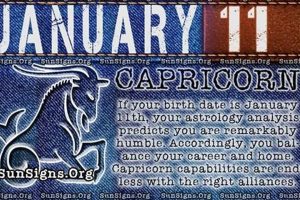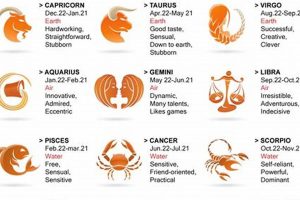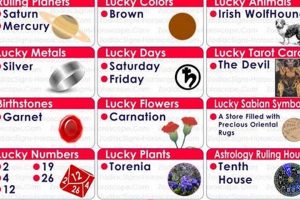On January 21, 2025, a specific configuration of planets is anticipated. This astronomical event, where celestial bodies appear close together from Earth’s perspective, holds significance for astrologers, who interpret such alignments as potentially influential on terrestrial affairs. While astronomy provides the scientific measurement of celestial positions, astrology assigns symbolic meaning to these configurations.
Historically, planetary alignments have captivated human attention, inspiring myths, legends, and predictions across various cultures. Modern astrologers view these events as opportunities for reflection and understanding, potentially offering insight into collective and individual experiences. This specific date in 2025 may be seen by some astrological practitioners as a moment of potential shifts in energy or focus.
Further analysis may explore the specific planets involved, their astrological signs, and the potential themes this alignment might represent. An examination of different astrological interpretations could provide a richer understanding of this celestial event and its potential significance.
While the astrological implications of specific planetary alignments remain a matter of interpretation, certain practices can facilitate reflection and self-awareness during such periods.
Tip 1: Consider Journaling: Documenting thoughts and feelings during this period can provide valuable personal insights over time, potentially revealing patterns or themes related to the astrological influences.
Tip 2: Explore Different Astrological Perspectives: Consulting various astrological resources, including those focusing on different traditions or techniques, can offer a broader understanding of potential interpretations.
Tip 3: Focus on Self-Reflection: Rather than seeking definitive predictions, utilize this time for introspection. Consider personal goals, values, and areas for potential growth.
Tip 4: Connect with Nature: Spending time outdoors can foster a sense of grounding and connection, offering a counterpoint to the introspective focus on astrological influences.
Tip 5: Practice Mindfulness: Engaging in mindfulness exercises, such as meditation or deep breathing, can enhance self-awareness and facilitate a deeper connection with inner experiences.
By engaging in these practices, individuals can cultivate greater self-awareness and utilize astrological insights as tools for personal growth and reflection.
These preparatory steps can lead to a more meaningful experience of this particular celestial event.
1. Planetary Positions
Planetary positions on January 21, 2025, are fundamental to astrological interpretations of this specific alignment. These positions, precisely calculated by astronomical observation, serve as the foundation for understanding the astrological chart and its symbolic meaning. Each planet’s placement within a specific zodiac sign and its angular relationships with other planets contribute to the overall astrological narrative.
- Zodiacal Placement
A planet’s presence in a particular zodiac sign imbues it with specific qualities associated with that sign. For instance, a planet in Aries might be interpreted as expressing assertive energy, while a planet in Pisces could be linked to themes of empathy and intuition. The combination of planetary and zodiacal energies forms a key element of astrological interpretation.
- Angular Relationships (Aspects)
The angles formed between planets in the astrological chart, known as aspects, signify dynamic interactions. A conjunction, where planets appear close together, suggests a blending of their influences. Other aspects, such as squares or oppositions, might represent tension or challenges. Understanding these angular relationships provides further nuance to the astrological interpretation.
- House Placement (In Some Astrological Systems)
Certain astrological systems utilize houses, which represent different spheres of life. A planet’s placement within a specific house adds another layer of meaning, relating its influence to a particular area of experience, such as career, relationships, or finances. This adds a more personalized dimension to astrological interpretations.
- Planetary Dignities and Debilities
Traditional astrology considers the concept of planetary dignities and debilities. A planet in its “domicile” or “exaltation” is considered strong and its influence more pronounced. Conversely, a planet in its “detriment” or “fall” is viewed as weakened. These factors further refine the astrological analysis, adding complexity to the interpretation.
The precise planetary positions on January 21, 2025, create a unique celestial configuration. By analyzing these positions within the framework of zodiacal placements, angular relationships, house placements (where applicable), and planetary dignities, astrologers can develop interpretations of this alignment’s potential significance, offering insights into potential themes and influences relevant to this specific date.
2. Astrological Chart
The astrological chart serves as a visual representation of the celestial landscape at a specific moment in time. For the date January 21, 2025, this chart maps the precise positions of the planets within the zodiac, providing the foundation for astrological interpretation related to this particular planetary alignment. Understanding the components of this chart is essential for deciphering its potential astrological significance.
- Planets in Signs
The placement of each planet within a specific zodiac sign modifies its expression. For instance, Mars in Capricorn might be interpreted differently than Mars in Sagittarius. The chart for January 21, 2025, will reveal the specific sign placements for each planet, offering clues to the dominant energies at play during this alignment. This information provides a basis for understanding the potential themes associated with the alignment.
- Planetary Aspects
Planetary aspects, the angular relationships between planets on the chart, reveal the dynamic interplay of planetary energies. A conjunction, where planets are close together, suggests a fusion of influences. Squares and oppositions might indicate points of tension or conflict. The aspects present in the January 21, 2025, chart provide insights into the potential challenges and opportunities associated with this alignment.
- Astrological Houses (In Some Systems)
Some astrological traditions incorporate houses, which divide the chart into twelve segments representing different life areas. The planets’ placement within these houses offers a nuanced perspective on how the alignment might manifest in specific domains of life, such as career, relationships, or finances. This provides a more personalized lens through which to interpret the alignment’s potential impact.
- The Ascendant and Midheaven
The Ascendant, the sign rising on the eastern horizon at the specific time and location, represents one’s outward persona and approach to life. The Midheaven, the point at the top of the chart, relates to career and public image. These points in the January 21, 2025, chart offer further context for understanding how this alignment could influence individual experiences and broader societal trends.
By synthesizing information from these elementsplanetary positions in signs, aspects, houses (if applicable), and the angles of the ascendant and midheavenastrologers can develop a comprehensive interpretation of the astrological chart for January 21, 2025. This chart provides a roadmap for navigating the potential influences and energies associated with this particular planetary alignment, offering valuable insights into its potential significance on both individual and collective levels.
3. Symbolic Interpretations
Astrology relies heavily on symbolic interpretations to understand celestial events. The planetary alignment on January 21, 2025, is no exception. By analyzing the symbolism associated with the planets involved, their positions in the zodiac, and their angular relationships, astrologers derive potential meanings and influences attributed to this specific alignment. These interpretations offer a framework for understanding the potential themes and energies associated with this celestial configuration.
- Planetary Symbolism
Each planet embodies specific archetypal energies and principles. Mars, for example, is associated with action and assertion, while Venus represents love and harmony. The combination of planetary energies present on January 21, 2025, contributes to the overall symbolic meaning of the alignment. For instance, a prominent Mars-Venus aspect might suggest a focus on balancing assertive action with relational harmony.
- Zodiacal Symbolism
The zodiac signs, through which the planets transit, add another layer of symbolic meaning. Each sign possesses unique qualities. Capricorn represents structure and ambition, while Pisces embodies empathy and spirituality. A planet’s placement in a particular sign colors its expression. Therefore, Mars in Capricorn may manifest differently than Mars in Pisces. The zodiacal placements on January 21, 2025, contribute to the nuanced interpretation of this alignment.
- Aspect Symbolism
Planetary aspects, the angular relationships between planets, represent dynamic interactions. Conjunctions symbolize a blending of planetary energies, while squares or oppositions suggest tension or conflict. The aspects present on January 21, 2025, offer insights into the potential challenges and opportunities associated with this alignment. For example, a harmonious trine aspect might suggest ease and flow in certain areas of life, while a challenging square aspect might indicate areas requiring greater focus and attention.
- Cultural and Mythological Symbolism
Astrology often draws upon cultural and mythological associations to enrich symbolic interpretations. These associations provide a deeper historical and archetypal context for understanding planetary influences. For example, Saturn’s association with limitations and structure draws upon its mythological role as the god of time and boundaries. These broader cultural and mythological frameworks add depth to the interpretation of the January 21, 2025, alignment, offering richer insights into its potential societal and individual implications.
Through the synthesis of these symbolic layersplanetary, zodiacal, aspectual, and culturalastrologers craft interpretations of the January 21, 2025 planetary alignment. This symbolic language provides a framework for understanding the potential influences and themes associated with this specific celestial configuration, offering potential guidance and insight into its broader significance.
4. Potential Influences
Astrological interpretations of planetary alignments often suggest potential influences on individual and collective experiences. While these influences are not deterministic predictions, they offer potential themes and areas of focus relevant to the specific alignment. Examining the potential influences associated with the January 21, 2025, planetary alignment requires careful consideration of the astrological symbolism involved and its potential manifestations in various life areas.
- Shift in Collective Consciousness
Planetary alignments can be interpreted as reflecting shifts in collective consciousness. The specific planetary energies at play on January 21, 2025, may correspond to emerging societal trends, cultural shifts, or global events. For example, a prominent Jupiter-Saturn aspect might suggest a focus on balancing expansion with structure, potentially influencing economic or political developments. The precise nature of these shifts would depend on the specific astrological configuration.
- Impact on Individual Experiences
While collective influences provide a broad context, planetary alignments can also impact individual experiences. The January 21, 2025, alignment might be interpreted as highlighting specific themes or challenges relevant to personal growth. For example, a Mars-Neptune aspect might suggest a need to balance assertive action with intuitive guidance, potentially influencing creative pursuits or spiritual practices. Individual birth charts provide a more personalized perspective on how these influences might manifest.
- Catalysts for Change and Transformation
Astrologers often view planetary alignments as potential catalysts for change and transformation. The specific energies present on January 21, 2025, could represent opportunities for personal or collective evolution. For instance, a Uranus transit might signify unexpected breakthroughs or shifts in perspective, potentially leading to significant life changes. The nature and intensity of these transformative influences would depend on the specific astrological factors involved.
- Themes of Growth and Development
Planetary alignments can highlight specific themes related to personal growth and development. The January 21, 2025, alignment may bring certain life areas into focus, prompting individuals to examine their beliefs, values, and patterns of behavior. For example, a Saturn transit might present opportunities for developing greater discipline and responsibility, while a Jupiter transit could encourage expansion and exploration. The specific areas of growth highlighted would depend on the individual’s birth chart and the overall astrological context.
By exploring these potential influencescollective shifts, individual experiences, catalysts for change, and themes of growthwithin the context of the specific planetary positions and astrological symbolism associated with January 21, 2025, individuals can gain a deeper understanding of the potential energies and opportunities present during this alignment. While astrological interpretations offer potential insights, they should not be viewed as deterministic predictions. Rather, they serve as tools for self-reflection and exploration, encouraging individuals to engage with the celestial energies in a mindful and discerning manner.
5. Individual Significance
While the January 21, 2025 planetary alignment may suggest broader societal trends, its significance can manifest uniquely for each individual. Astrology posits that the impact of such alignments is filtered through the lens of one’s birth chartthe specific planetary positions at the time of birth. This natal chart acts as a blueprint of individual predispositions and potentials, modifying the influence of transiting planets, including those involved in the January 21, 2025 alignment.
Consider, for instance, two individuals born under different sun signs. One might have a natal sun in Aries, while the other has a natal sun in Pisces. A transit of Mars through Capricorn during the January 21, 2025 alignment could manifest differently for each. The Aries individual might experience this transit as a surge of ambition and drive in their career, while the Pisces individual might feel a greater need for emotional grounding and self-reflection. This differentiation arises from the interaction between the transiting Mars in Capricorn and the individual’s natal planetary placements.
Further personalization arises from the interplay of transiting planets with the houses of the natal chart. If the January 21, 2025 alignment activates an individual’s seventh house, which relates to partnerships, the impact might be felt most strongly in their relationships. Another individual, with the alignment activating their tenth house of career, might experience shifts in their professional trajectory. This house-based interpretation provides a more specific lens through which to understand the potential impact of the alignment.
Understanding the individual significance of the January 21, 2025, alignment requires analyzing its interaction with personal astrological factors. This nuanced approach recognizes that astrological influences are not generic but rather personalized, reflecting the unique interplay of transiting and natal planetary energies. By examining the alignment’s impact through the lens of individual birth charts, a deeper understanding of its potential significance for personal growth and development can emerge. Though interpretations may vary, the core principle remains: astrological events unfold uniquely within the context of individual lives.
6. Collective Impact
Astrological interpretations often extend beyond individual experiences to encompass potential collective impacts. The planetary alignment on January 21, 2025, may be viewed through this lens, suggesting potential influences on societal trends, cultural shifts, and global events. While individual birth charts provide a personalized perspective, examining the collective impact requires considering broader astrological themes and their potential manifestations in the world at large.
- Generational Influences
Planetary alignments, particularly those involving slow-moving outer planets, can be associated with generational influences. The January 21, 2025 alignment, depending on the specific planets involved, might signify emerging values, priorities, or challenges for specific cohorts. For instance, if the alignment involves a prominent Pluto transit, it could be interpreted as a period of transformation and upheaval, potentially influencing generational attitudes towards power structures or societal norms.
- Cultural Shifts
Astrology often links planetary alignments with cultural shifts and evolving societal trends. The specific astrological configurations on January 21, 2025, might correlate with changes in artistic expression, technological advancements, or evolving social dynamics. For example, a prominent Uranus transit could be associated with a period of innovation and disruption, potentially influencing communication technologies or social movements. The precise nature of these cultural shifts would depend on the overall astrological context.
- Global Events
Some astrologers interpret major planetary alignments as potentially correlating with significant global events. These events could encompass economic developments, political shifts, or environmental changes. The January 21, 2025 alignment, depending on the astrological factors involved, might be interpreted as influencing international relations or global economic trends. For instance, a Jupiter-Saturn alignment could suggest a period of economic restructuring or shifts in global power dynamics. It’s important to note that these interpretations are not predictive but rather suggestive of potential themes.
- Archetypal Themes
Planetary alignments often evoke specific archetypal themes. The January 21, 2025 configuration might be associated with themes of balance, integration, or transformation, depending on the specific planets and their astrological relationships. These archetypal themes can manifest in various ways, influencing collective narratives, cultural expressions, or spiritual movements. For instance, a Neptune transit might emphasize themes of compassion and interconnectedness, potentially influencing artistic expression or spiritual practices.
Analyzing these facetsgenerational influences, cultural shifts, global events, and archetypal themeswithin the context of the January 21, 2025 planetary alignment provides a broader perspective on its potential collective impact. While individual experiences remain unique, understanding these broader astrological influences can offer valuable insights into the potential societal and cultural trends emerging during this period. It is crucial to remember that astrological interpretations offer potential themes and areas of focus, not deterministic predictions. These interpretations encourage a deeper engagement with the complexities of individual and collective experiences within a larger astrological framework.
Frequently Asked Questions
This section addresses common inquiries regarding the astrological significance of the January 21, 2025 planetary alignment. The responses aim to provide clarity and foster a deeper understanding of this celestial event from an astrological perspective.
Question 1: Does the January 21, 2025 alignment guarantee specific life events?
Astrology does not offer deterministic predictions. Planetary alignments suggest potential themes and influences, not guaranteed outcomes. Individual responses to these influences vary.
Question 2: How does this alignment differ from other planetary alignments?
Each planetary alignment is unique due to the specific planets involved, their zodiacal placements, and their angular relationships. The January 21, 2025 alignment presents a distinct celestial configuration with its own set of potential interpretations.
Question 3: Is there a consensus among astrologers about this alignment’s meaning?
Astrology encompasses diverse perspectives and interpretive methods. While general themes might emerge, interpretations can vary among astrologers depending on their chosen tradition and analytical approach.
Question 4: How can one prepare for this astrological event?
Engaging in practices like self-reflection, journaling, and connecting with nature can foster greater self-awareness during this period. Openness to potential insights and a willingness to explore personal growth are beneficial.
Question 5: What is the relationship between astronomy and astrology regarding this alignment?
Astronomy provides the precise measurements of celestial positions, while astrology assigns symbolic meanings to these configurations. Astronomy informs the astrological chart, which astrologers then interpret.
Question 6: Where can one find reliable information about this alignment’s astrological significance?
Reputable astrologers, established astrological organizations, and well-researched publications offer valuable resources for understanding this alignment’s potential astrological implications. Discernment in selecting sources is crucial.
Careful consideration of these points allows for a more nuanced approach to understanding the potential significance of the January 21, 2025 planetary alignment within a broader astrological context.
Further exploration might involve examining specific astrological interpretations related to this alignment, including its potential impact on various life areas or its connection to historical cycles and broader societal trends. Consultations with qualified astrologers can offer personalized guidance.
Conclusion
This exploration of the January 21, 2025 planetary alignment has examined its potential astrological significance from various perspectives. Analysis of planetary positions, symbolic interpretations, potential individual and collective influences, and frequently asked questions provides a framework for understanding this celestial event. While definitive predictions remain outside the scope of astrological interpretation, the examination of planetary symbolism, angular relationships, and zodiacal placements offers valuable insights into potential themes and energies associated with this specific alignment. Individual experiences will undoubtedly vary, filtered through the unique lens of personal birth charts.
The January 21, 2025 planetary alignment serves as a reminder of the interconnectedness between celestial phenomena and human experience. Whether one approaches this event from a place of astrological curiosity or personal significance, it offers an opportunity for reflection, self-discovery, and a deeper engagement with the cosmos. Further research and exploration can provide a richer understanding of this particular alignment’s potential influences on both individual and collective levels. Continued observation of unfolding events may offer further insights into the manifestation of these astrological interpretations over time.







